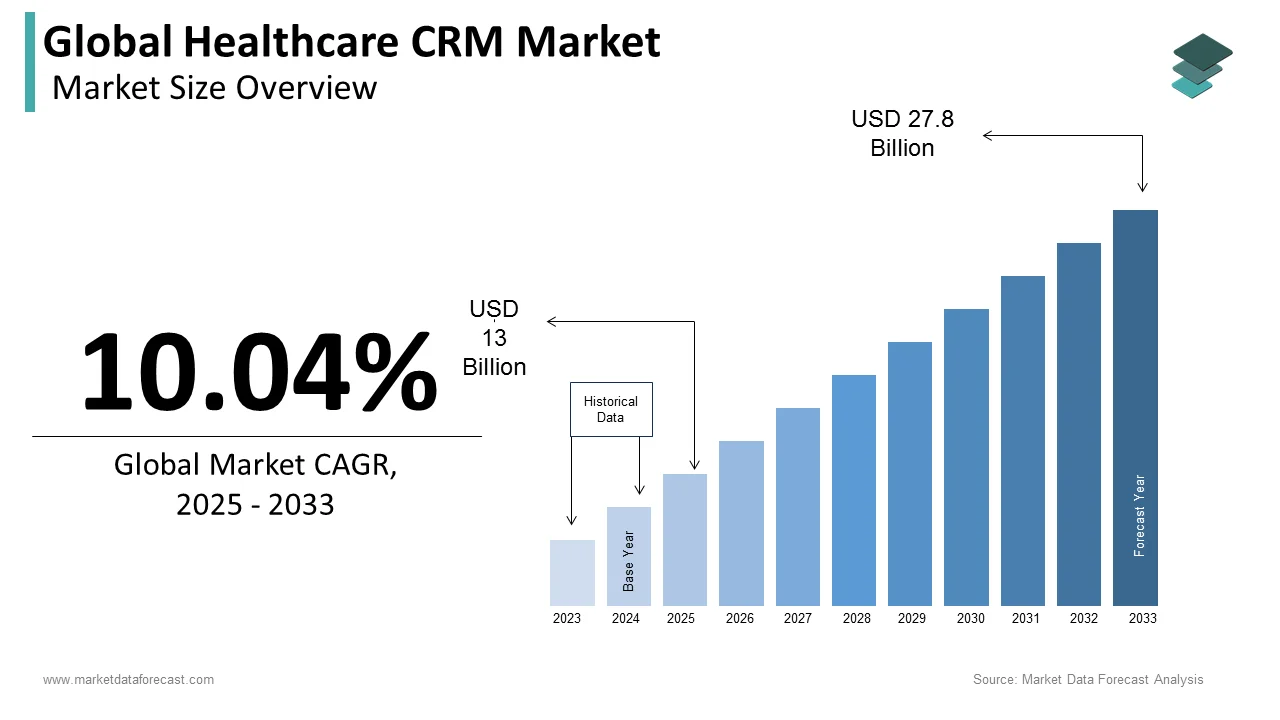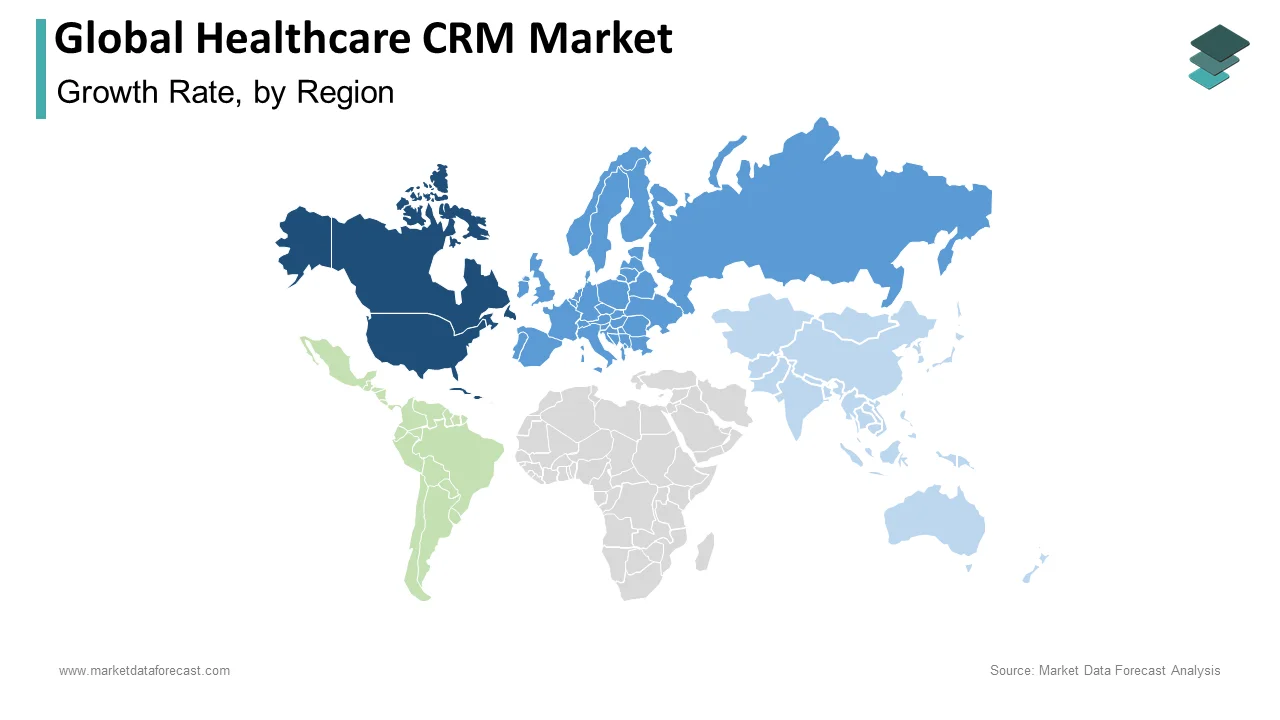Global Healthcare CRM Market Size, Share, Trends & Growth Forecast By Product, Application, End-user, Technology and Region (North America, Europe, Asia-Pacific, Latin America, Middle East and Africa), Industry Analysis From 2025 To 2033.
Global Healthcare CRM Market Size
The global healthcare CRM market was valued at USD 11.74 billion in 2024. The global market is projected to grow from USD 13 billion in 2025 to reach USD 27.8 billion by 2033, exhibiting a compound annual growth rate (CAGR) of 10.04% during the forecast period 2025-2033.

Healthcare CRMs collect a large amount of patient data from various sources. Increasing administrative expenditures are becoming more typical in the healthcare industry. These charges push healthcare prices for everyone, making it difficult for most people to afford them. The capacity to leverage automation, machine learning and artificial intelligence services in the healthcare sector has prompted their adoption. Healthcare firms rapidly use CRM systems to improve sales, services, and marketing operations and get more significant ROI. These solutions are making the work considerably more uncomplicated by lowering administrative expenses and increasing the need for healthcare CRM.
MARKET DRIVERS
The healthcare industry is undergoing a revolution unlike any other due to the emergence of new apps and technologies such as digital chatbots, record-keeping software, and real-time interactions. As a result, the global healthcare CRM market is expected to have a robust growth environment throughout the forecast period.
Growing expenditure and complications of CRM applications are propelling the growth of the healthcare CRM market.
Due to intense competition, shifting dynamics and tactics of hospitals worldwide are expected to increase client outreach and marketing approaches. The increased need for patients to receive early treatment through home care, virtual care, mobile monitoring, and illness monitoring apps is most likely to create new market growth opportunities. In addition, the penetration of high-speed internet, including long-term evolution and 4th generation devices such as smartphones, tablets, and iPads, has provided a platform for communicating with patients from remote areas without an uninterrupted routine. Furthermore, new database reorganization and economic development methods are anticipated to maintain this sector's competitiveness in the coming years.
The government's partnership with the patient, provider, and payer communities is further estimated to boost the healthcare CRM market.
The availability of healthcare infrastructure, advancing healthcare facilities, and increasing healthcare expenditure, investment, and funding by the government encourage market growth. Over the years, the e-CRM service has had a larger population of users than any other healthcare CRM. Further, the market expansion might be fuelled by establishing many hospitals, a preference for centralized systems, and organized workflow and automated operations. Numerous studies have demonstrated the relevance of customer satisfaction in all businesses. According to evidence, more vital customer satisfaction leads to higher faithfulness, isolating a medical organization from its rivals.
MARKET RESTRAINTS
However, lack of awareness about CRM in healthcare and unfavorable reimbursement policies are the major growth restraints to the market. In addition, the high cost of CRM installation is a vital issue projected to limit the worldwide market's growth. Furthermore, mounting worries about patient data security are another issue predicted to stifle the target market's expansion to a certain level.
REPORT COVERAGE
|
REPORT METRIC |
DETAILS |
|
Market Size Available |
2024 to 2033 |
|
Base Year |
2024 |
|
Forecast Period |
2025 to 2033 |
|
CAGR |
10.04% |
|
Segments Covered |
By Product, Application, End-user, Technology, and Region. |
|
Various Analyses Covered |
Global, Regional, and country-level analysis; Segment-Level Analysis, DROC; PESTLE Analysis; Porter’s Five Forces Analysis, Competitive Landscape; Analyst Overview of Investment Opportunities |
|
Regions Covered |
North America, Europe, APAC, Latin America, Middle East & Africa |
|
Market Leaders Profiled |
Amdocs Ltd, Microsoft, Oracle, IBM, SAP, Accenture Plc, AllScripts Healthcare Solutions Inc., Anthelio Healthcare Solutions, Siemens Healthcare, Accretive Health Inc., Salesforce, NetSuite, Aspect Software, Cerner, Lawson, Talisma, Nice Systems, Verint Systems, and Veeva, and Others. |
SEGMENTAL ANALYSIS
By Product Insights

Based on the product, the individual and referral services segment will dominate the market during the forecast period. Because of shifting business models and the continual desire for integration between the patient, provider, and payer, individuals and referrals will likely obtain the most market share throughout the projected period. In addition, the transition from volume to value-based care is expected to increase referral CRM growth.
Moreover, the referral segment is projected to be the fastest-growing by 2033.
By Application Insights
Based on the application, case management is expected to account for a significant global market share during the forecast period. The factors growing chronic diseases and behavioral disorders are influencing the market growth. Furthermore, case management entails collaboration between primary healthcare professionals, care managers, and patients to treat a high-impact condition. Therefore, the relationship management segment will likely augment the market over the forecast period.
By End-User Insights
The payer segment is anticipated to record the largest market share based on the end user. For example, insurance firms are payers; hospitals, clinics, and different specialized facilities such as hospice care and long-term care are providers; and life sciences firms such as pharmaceutical and biotechnology corporations, as well as Clinical Research Organizations, are payers (CROs); therefore, the usage of the goods in life science is predicted to provide the fastest growth for the category.
By Technology Insights
The mobile customer services segment is projected to be one of the fastest-growing segments during the forecast period based on the technology. The segment growth is attributed to the increasing number of pharmaceutical companies across the globe and growing adoption rates among physicians and patients.
On the other hand, the cloud-based segment is expected to be the fastest-growing segment and witness significant CRM market share over the forecast period. Also, the social segment will likely showcase the highest share because consumerism is rising, leading to a more empowered patient.
The predictive analysis segment is predicted to grow in the coming years owing to the rise in the penetration of virtual care and the adoption of advanced technology in the healthcare industry. In addition, collaborative CRM is estimated to rise in response to an increased need for care coordination, management, and integrated care.
REGIONAL ANALYSIS
The North American healthcare CRM market held the largest share of the global market in 2024.
The presence of the most prominent market players, the US and Canada, and the availability of advanced technology in the healthcare sector drive the region's market growth. In the regional market, the United States recorded the largest market share. Growing collaborations and advancing infrastructure propelling the market in the country. In 2017, Salesforce (US) was the industry leader in healthcare CRM, accounting for 22% of the market. Salesforce is the CRM solution supplier for over 100,000 businesses looking to optimize their operations. With its SaaS products, the corporation has a significant cloud presence. Salesforce's strength is its ability to offer innovation and successfully engage customers.
The European healthcare CRM market is anticipated to grow significantly during the forecast period. Supportive government initiatives and affordable healthcare acts are augmenting the market growth. The major growth contributors in the region are the UK, Germany, France, Spain, and Italy. The UK is likely to witness the largest market in Healthcare CRM owing to the rising demand for patients to receive early treatment through home care and virtual care.
The APAC healthcare CRM market is one of the fastest-growing regions in the global market and is expected to have the highest share globally during the forecast period. Rising investments in the industry and international company operations in emerging countries such as India. China and Japan are projected to have significant growth in the healthcare CRM market in the years to come. The availability of technologically updated healthcare infrastructure in this region is further expected to boost the growth rate of the APAC healthcare CRM market.
The Indian Healthcare CRM market is anticipated to account for the most significant share in the APAC region in the coming years. The increasing healthcare spending and the rising number of hospitals are increasing the market growth. Moreover, high-speed internet penetration, including long-term evolution and 4th generation devices such as smartphones, is expected to gain the highest market share.
The Latin American healthcare CRM market is expected to grow at a CAGR of 8.98% from 2025 to 2033.
The MEA healthcare CRM market is forecasted to register a CAGR of 6.8% during the forecast period.
KEY MARKET PARTICIPANTS
Amdocs Ltd, Microsoft, Oracle, IBM, SAP, Accenture Plc, AllScripts Healthcare Solutions Inc., Anthelio Healthcare Solutions, Siemens Healthcare, Accretive Health Inc., Salesforce, NetSuite, Aspect Software, Cerner, Lawson, Talisma, Nice Systems, Verint Systems, and Veeva are a few of the dominating companies in the global healthcare CRM market.
MARKET SEGMENTATION
This research report on the global healthcare CRM market has been segmented and sub-segmented based on product, application, end-user, technology & region.
By Product
- Individual
- Referral
- Individual and referral
By Application
- Community Outreach
- Community Health Education
- Services Outreach/Promotion
- Financial Donor Management
- Case Coordination
- Patient Information Management
- Pre-Authorizations / Eligibility
- Referrals
- Others
- Case Management
- Chronic Disease Management
- Clinical Trials Relationship Management
- Relationship Management
By End-User
- Payers
- Providers
- Life Science Companies
By Technology
- Cloud-Based
- Mobile
- Social
- Collaborative
- Predictive
By Region
- North America
- Europe
- APAC
- Latin America
- MEA
Frequently Asked Questions
How big is the healthcare CRM market?
The global healthcare CRM market size is estimated to be USD 11.74 billion in 2024 and is predicted to hit USD 27.8 billion by 2033.
Which segment by application is expected to dominate the healthcare CRM market in the coming years?
The case management segment is expected to showcase among all the others in the healthcare CRM market in the coming years.
Which region is expected to grow the fastest in the global healthcare CRM market?
The APAC region is forecasted to be rising at an aggressive CAGR from 2025 to 2033 in the global healthcare CRM market.
What are the companies playing a key role in the healthcare CRM market?
Companies playing a promising role in the global healthcare CRM market are Amdocs Ltd, Microsoft, Oracle, IBM, SAP, Accenture Plc, AllScripts Healthcare Solutions Inc., Anthelio Healthcare Solutions, Siemens Healthcare, Accretive Health Inc., Salesforce, NetSuite, Aspect Software, Cerner, Lawson, Talisma, Nice Systems, Verint Systems, and Veeva.
Related Reports
Access the study in MULTIPLE FORMATS
Purchase options starting from $ 2500
Didn’t find what you’re looking for?
TALK TO OUR ANALYST TEAM
Need something within your budget?
NO WORRIES! WE GOT YOU COVERED!
Call us on: +1 888 702 9696 (U.S Toll Free)
Write to us: [email protected]

